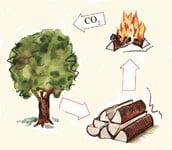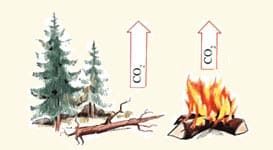Firewood – Fuel for the future
‘T’s been said that a long straight row of firewood standing in the yard in springtime is like money in the bank. It is indeed. As it dries in the summer sunshine, you’re collecting interest.’
Varieties of Firewood.
Some people have a preference for hardwoods because of flame patterns and lasting glowing embers. This is true to some extend in open fireplaces. However in heat accumulating stoves and fin ovens, fast burning timber is more suitable. When you burn hard wood preferably mix with soft woods. The quick burst of heat of dry soft wood ( birch, spruce, willow, larch, etc ) is no problem at all in a heat accumulating stove because the fire only needs to burn for a few hours in order to store a day of radiant heat. There is no risk for the sparks of soft wood while the fire is controlled behind a door in an enclosed environment, returning an efficiency of between 80 and 95 % to the stone mass.
Dry Split Firewood
More important than the variety of firewood is the moisture content of firewood. Moisture left in the fire wood absorbs an amazing amount of the heat produced in the burn cycle as well as sooting up the chimney and flue ducts in the stove. Green firewood can have a moisture content of over 50 %. Dry seasoned fire wood has a moisture content of 12 to 20 %, of course the drier the better. A cubic metre of fire wood down to 20 % moisture still contains 200 litres of water and that is the maximum content in order to burn clean and also produce heat.
The thermal value of 100 % dry firewood is 5,1 to 5,3 kW per Kg, ( not naturally occurring )
The thermal value at 15 % moisture content is approximately 4,1 kW per Kg.
The bark on wood is difficult to ignite , that is why it is always advisable to split firewood, this also speeds up the drying process. With small pieces of firewood , you create a greater surface and gasification area. This quickly results in a hot fire.
Soft wood has to be stored for at least 2 years, hard wood for at least 3 years. Still the longer the better and you can always check with a moisture measuring gauge. It is also recommended to store inside the home the quantity of fire-wood needed for at least 1 or 2 days.
Recycled Firewood
When you burn recycled timber, make sure it is untreated. Make sure it has not been preserved with chemicals or paint. This for your own health as well as for your neighbours and the environment.
Tips for Storing Firewood
Firewood is best stored in an airy space under a roof sheltered from the prevailing winds. Air movement is needed but rain has to stay out because even seasoned firewood will take on moisture again when it gets wet.
In a wet climate it may be good to store firewood in a poly tunnel with some air vents or under a glass or poly carbonate roof. By doing so you are creating some kind of a solar kiln that will dry your firewood in a shorter period of time.
Always store your fire-wood of the ground, e.g on wooden pallets or some other suitable airy floor material. Also alternate the layering direction every now and than for airing purpose. Hard-woods such as oak and beech should be left outside for a year , than cut and split and stored to season for 2 years
Always cut firewood to a length that comfortably fits the size of your stove. Split your firewood , round rings into 4 pieces or more. A good indication for dry firewood: It is light in weight and by hitting 2 pieces together it produces a clear sound.
Tips on Cleaning , Ventilation and Burning
Keep your fireplace / stove and chimney clean. Sweep your chimney at least once a year.It is better to air your living space several times a day in quick bursts instead of having a window open all the time. Occasionally we all like to watch the fire with open door. When doing so please burn dry wood like beech or birch to prevent sparking , do not use resinous fire wood with an open door. Note that burning a fire with an open door is inefficient, because of incomplete combustion. The fire takes in too much cold air, cooling down the fire and creating a big draft up the chimney as with an open fireplace.
Why Choose a Wood Burning Heat Storing Accumulating stove
- Not to be dependent on rising oil and gas prices.
- Using home grown / locally produced fire wood.
- Being environmentally friendly by burning carbon neutral wood.
- Heating the home by means of a well designed piece of heating art.
- Living in a place that is warm with pleasant and healthy radiant heat, creating a natural atmosphere.
- Radiant heat does not heat the air inside a building, the air remains cool and easy to breath. It heats all the solid items, such as furniture and walls and they will radiate the heat back to you again.
- Because radiant heat does not heat the air itself, it prevents drafts and cold spots, neither does it create swirling dust particles.
- Firewood grows locally and is the cheapest fuel around. The use of firewood will sustain our woodlands and add to its diversity and maintenance.
- When growing woods, the trees absorb the same amount of CO2 from the atmosphere as what they produce while burning, and therefore are CO2 neutral.
- One ton of dry firewood can replace three hundred litres of oil.
In order to be able to burn dry firewood, it has to be stored for at least one year in a firewood depot which is airy and waterproof. One ton of firewood with a desirable 20% moisture content, still contains two hundred litres of water. Green firewood will contain four to five
hundred litres of water, or more per ton depending on the type of wood. Burning dry firewood in a finoven or woodgasifying boiler attributes to a clean and complete combustion, with a maximum gain of heat.
The carbon dioxide (CO2 )-cycle
The burning of wood produces carbon dioxide (CO2). Trees take up carbon dioxide from the air and in their leaves convert it into sugar, which is the basic nutrient of the trees. The reuse of wood as a fuel accomplishes a closed carbon dioxide cycle. Wood burning does not increase CO2 -concentration in the atmosphere
Wood that rots in a forest produces carbon dioxide, which in turn is released into the air.
The same amount of CO2 is released when wood is properly combusted in a stove. This does not increase carbon dioxide concentration as wood always gives off CO2 into the air, no matter whether it rots or burns. However, the burning of all other fuels – such as oil, gas, or coal – increases carbon dioxide concentration in the atmosphere.Wood burning does not foster the greenhouse effect. Moreover, incineration residues resulting from the burning of wood can be fully recovered: ashes are a biological fertilizer for your garden.


